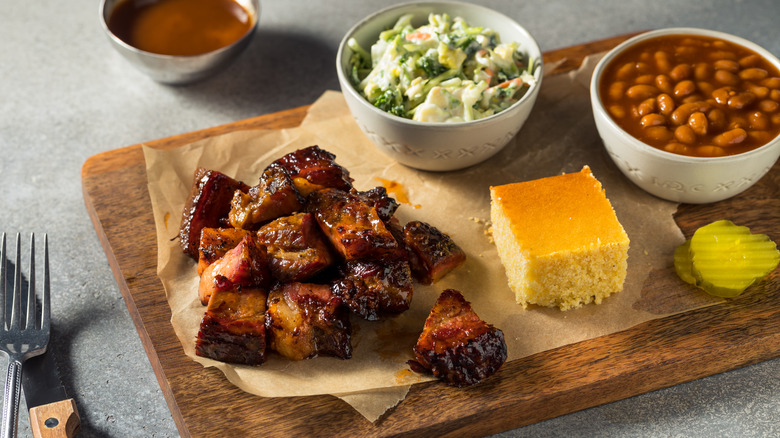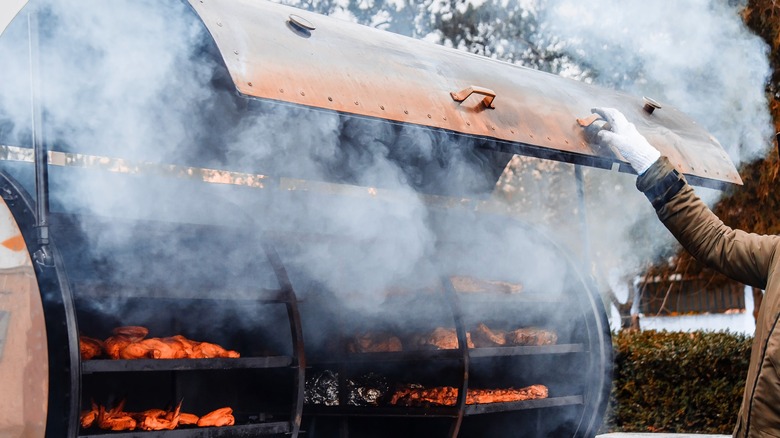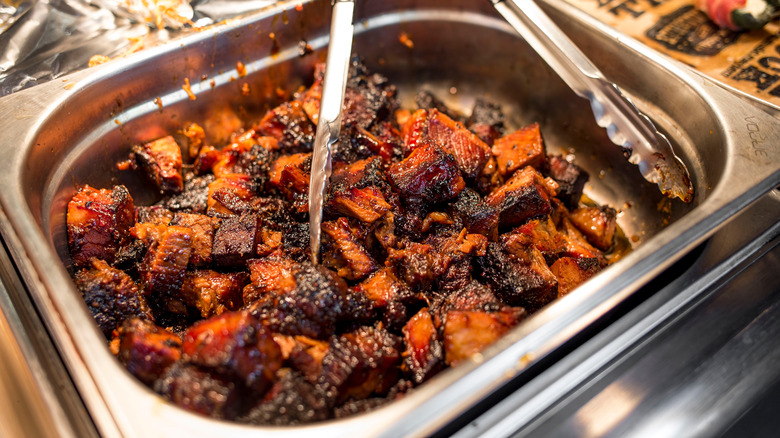Chuck Roast Is The Deliciously Cheap Alternative To Brisket Burnt Ends
Barbecue aficionados are always talking about place: the longitudinal divide between North Carolina's vinegar and mustard-based sauces; the piquant quality of a Memphis-style sauce; the various woods used to smoke Texas beef brisket; and the smoky-sweet joys of burnt ends from Kansas City. For the uninitiated, burnt ends are not actually burned. Instead, they're made from a part of the brisket known as the deckle (also known as the point or ribeye cap), which has been smoked to a crisp, cubed, then covered in barbecue sauce and brown sugar, and cooked until caramelized. If you can't make it to Kansas City any time soon, burnt ends are easily made at home — and if you want to save some money while not skimping on flavor, substitute chuck roast for brisket.
Both cuts are similar in that they're well-marbled in fat (and therefore delicious but require a longer cooking time) and come from the front of the cow. The difference is that the primal cut, known as brisket, is huge, and the animal only yields two. Chuck roasts come from the shoulder, but the meat known as beef chuck covers a large area and yields several different roast cuts. The differences are that brisket muscle is denser and considered tougher, while chuck is fattier, deeply flavorful (often referred to as "beefy"), and cheaper compared to just the deckle cut and especially the far larger and more expensive brisket.
The poor man's burnt ends
This dish is a far cry from your usual chuck roast application in a Sunday beef pot roast. Subbing chuck roast for brisket is called the "poor man's burnt ends," but there's no compromise in the taste. Typically, an entire brisket is smoked, or its fattier point is separated to be made into burnt ends. In the poor man's version, an entire chuck roast is turned into burnt ends, meaning a larger surface area will become dry and crisped (a quality referred to as "bark").
Apart from the smoking wood, barbecue dry rub, and sauce of your choice, the only thing you really need to make burnt ends is a smoker — because you'll need to not only smoke the meat but maintain a pretty low temperature (not more than 275 degrees Fahrenheit) for a very long time. (Virtually the same process is required for the deckle, and goodness knows that smoking a whole brisket is quite the time investment.) You can shorten this process by cubing the chuck roast first if you'd like.
Burnt ends history
What's hilarious about the term "poor man's burnt ends" is that, for a long time, burnt ends were trimmed from the brisket and thrown away. This ended when the geniuses at Arthur Bryant's Barbecue in Kansas City decided to give them away for free to customers waiting on their orders. Turns out that everyone has a taste for smokey-sweet nuggets, so when you visit Arthur Bryant's today you'll need to actually pay for your burnt ends.
This would have been a brilliant, provincial marketing trick had writer Calvin Trillin — who lived in New York City but was raised in Kansas City — called Arthur Bryant's "the single best restaurant in the world" in a 1972 essay for "Playboy" magazine. "The main course at Bryant's, as far as I'm concerned," Trillin rhapsodized, "is something that is given away for free — the burned edges of the brisket ... I dream of those burned edges." Back then, Trillin had to travel back home to make his dreams a reality; all you need to do is head to the grocery store to grab a chuck roast.


